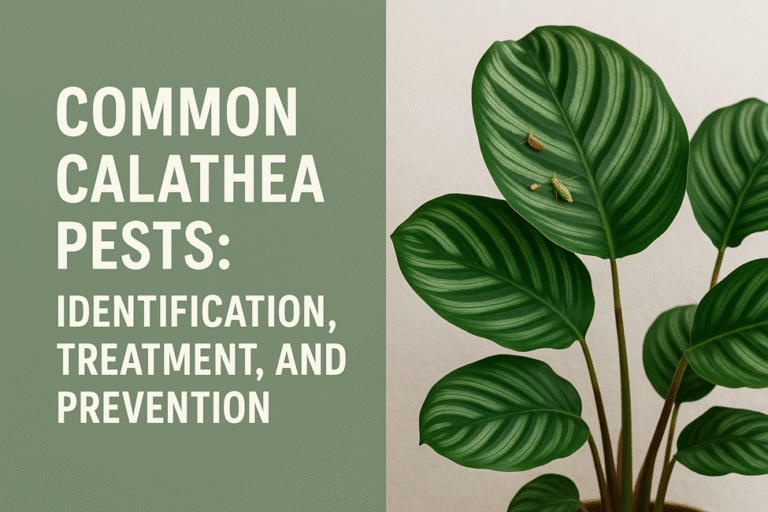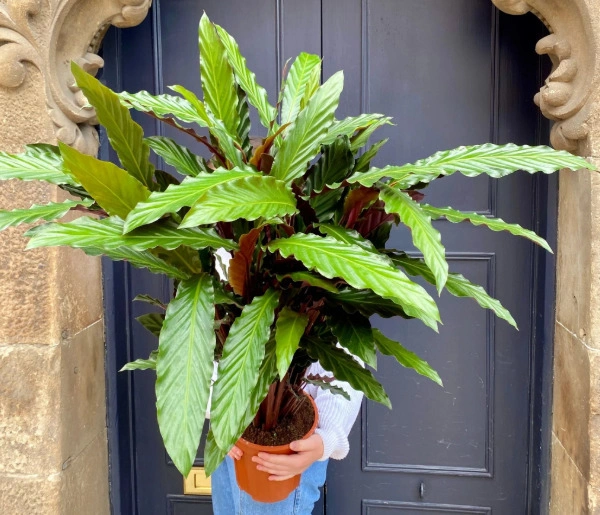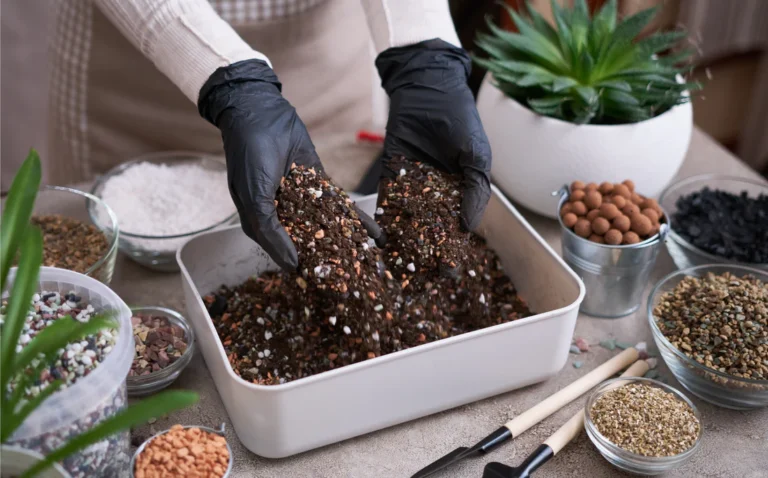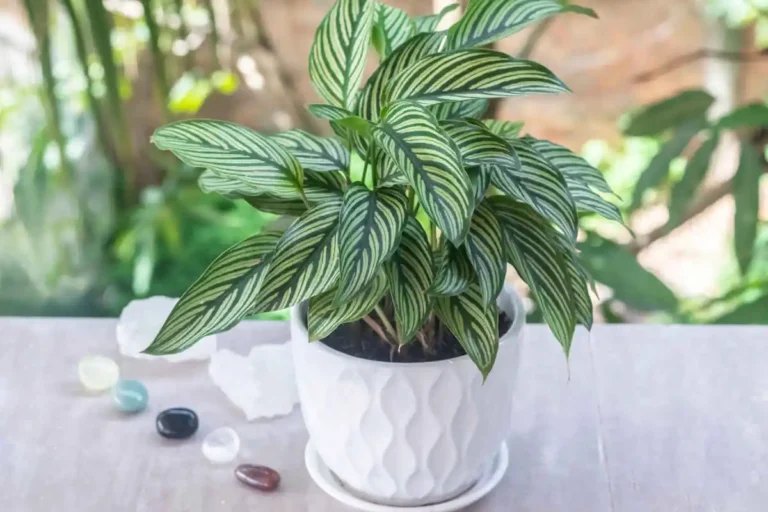How Big Do Calathea Plants Get?
One of the most commonly asked questions by calathea growers is how big do Calathea plants get?
Usually, Calathea plants can grow up to 2 feet (60 cm) in height and produce large leaves up to 2 feet wide when grown indoors. However, when grown outdoors, they can get up to 4 feet tall. Growth factors such as plant care and species significantly affect how big Calatheas can grow.
In this blog post, we will discuss tips and tricks for encouraging your Calathea plant to grow big and bushy and steps you can take to keep it small.
So, let’s get straight into it!

Do Different Calathea Varieties Have Different Height?
Yes! You might have noticed that different Calathea varieties look very different from each other. Calathea Warscewiczii and Ruibarba are taller varieties (up to 3 feet in height) with larger leaves than other species.
Conversely, Calathea roseopicta is a smaller variety that can grow up to 1.5 feet tall and is a perfect choice for growing indoors. Calathea size varies from variety to variety, but its height potential also depends on the care you provide.
How Fast Do Calatheas Grow Into a Mature Plant and Produce New Leaves?
Calatheas exhibit sluggish growth compared to common houseplants, such as the Spider Plant or Golden Pothos.
The indoor Calathea plants grow moderately, reaching maturity and a height of up to 2 feet within a year, and then stopping growing. Afterward, you must prune the yellow, crispy, or brown leaves for optimal growth.
Similarly, the frequency of new leaf growth also depends on the plant’s care and variety.
Generally, a Calathea plant will unfurl new leaves every month if you take care of it properly. If your Calathea plant is not growing any new leaves, follow the following Care guide.
How To Grow Calathea Big?
Calathea plants will not reach their full height potential if they don’t get enough water, indirect bright light, and essential nutrients to produce energy through photosynthesis.
Here is the step-by-step care guide that you should follow for Calatheas’ optimal growth.
1. Ensure Proper Watering
Water your Calathea plant at least once a week or when the top 2 inches of the soil feel dry.
If Calatheas are not watered properly, they face many issues. For example, when under-watered, the plants don’t have enough water to support turgidity and generate energy for growth. As a result, Calatheas produce droopy and curling leaves.
Conversely, overwatering promotes fungal attack, which may lead to root rot, preventing the roots from absorbing water and nutrients from the soil. As a result, the plant will produce yellowing and crinkled leaves.

For watering your Calathea, use only:
- Filtered or distilled water.
- Avoid using tap water as it deposits salts around the root area, hindering roots from absorbing water and nutrients.

Also check How Often and When to Water Calathea?
2. Provide Indirect Bright Sunlight
Calatheas require bright, indirect sunlight for optimal growth.
Exposure to direct, bright light can cause sunburn. Therefore, place your prayer plant:
Similarly, the plant will dormant if it does not get enough light during the winter. You can fix the issue by supplying the following:
3. Feed with Fertilizer During the Growth Season
Fertilize your Calathea plant once a month during its growth season with a fertilizer containing three primary growth nutrients: nitrogen (N), Phosphorus (P), and Potassium (K).
These nutrients boost the growth rate and help Calatheas to reach their full height potential. For example, Nitrogen accelerates chlorophyll and leaf growth, while Phosphorous encourages the formation of new, healthy roots and flowers. At the same time, Potassium strengthens the stems and makes them grow taller.
In addition, Calatheas also require some micronutrients in trace amounts, such as:
Following this consideration, feed your Calathea with a balanced NPK fertilizer once a month during its growth months: Spring and Summer. Always dilute the half-recommended dose before applying.
Avoid fertilizing them when it’s wintertime because they go dormant in winter. So, feeding them will add salt deposits around the roots and retard their growth.
4. Ensure High Humidity and Warm Temperatures
Calathea thrives well when it receives humidity around 60% and warm temperatures between 65 and 85 °F.

If the humidity levels fall below 50%, the plant will show a retarded growth. You can raise the humidity level around your plant by using a:
Similarly, temperatures above or below this range can cause retarded growth of the plant. So, place your plant where it receives enough sunlight to maintain the room temperature.
5. Grow Them in a Slightly Acidic Soil
Calathea plants love to grow in slightly acidic soil with a pH of approximately 6.5. They also prefer loamy, humusy soil that is embedded with essential nutrients.
For potted plants,
6. Repot Them Into a Larger Pot
Sometimes, you wonder if you have given your Calathea plant proper care, but still, it has yet to reach its full growth potential. What could be the reason behind it?
It could be the small pot size that is stopping the plant from growing correctly.
Smaller pots cause the Calathea plants to become rootbound. When roots take up all the space and start getting out of the pot, the soil has no room to hold water.
Therefore, you should:

7. Clean the Leaves for Dust
Cleaning your Calathea’s leaves regularly can be time-consuming, but it will give them room to grow larger.
Clean the dirt and dust from the leaves, as they can clog up the leaf’s stomata and slow down the process of photosynthesis. You can use a damp microfiber cloth to remove the dust every week. Cleaning the leaves also helps you find and eliminate pests before they become a big problem.
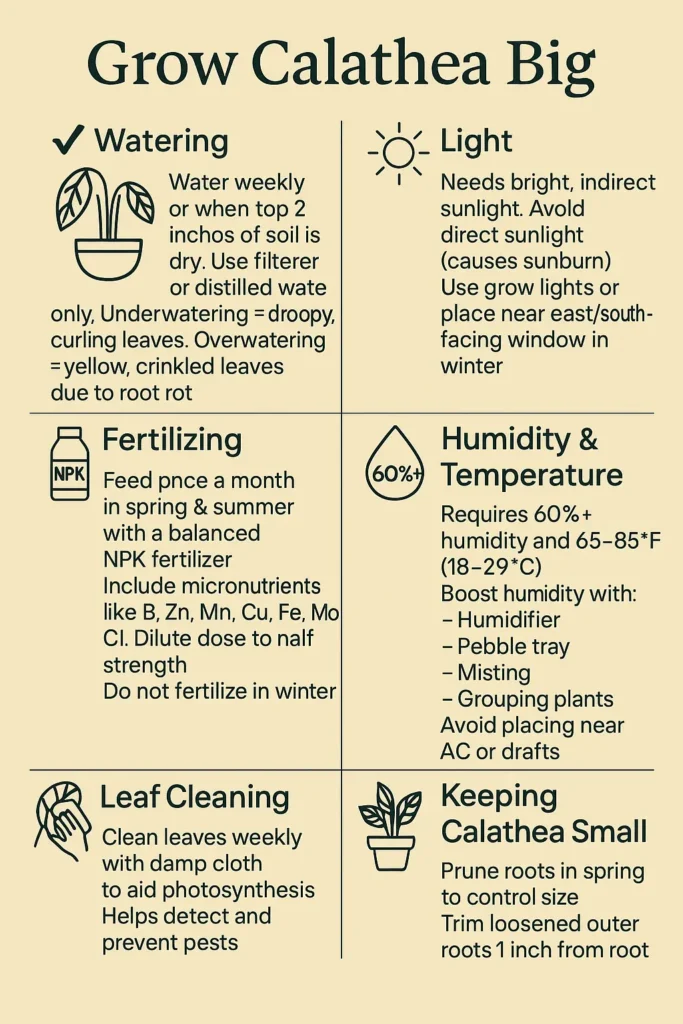
How to Keep Your Calathea Plants Small?
When growing a Calathea plant indoors, keep it small for aesthetics.
You can keep your Calathea small by considering the following strategies:
1. Pruning the Roots in Spring
Calathea growth depends on their root system. They will grow only as large as the root system they have. You can keep them small by pruning the roots once their growth starts in the spring.
To trim the roots, you need to:
How to Propagate Calathea for Optimal Growth?
Propagating your Calathea plant is the best way to maintain its size and get new plants. Spring or summer is the best time to propagate your Calathea as it grows exponentially during this period.
Root division is the most successful way to propagate and maintain the size of your plant. However, this is only possible when the mother plant is healthy and at least 2 years old.
Here are the steps for propagating Calathea through root division:
Also Check How to Propagate Calathea Plants?
Common Problems That Stop Calathea From Reaching Full Growth Potential and How to Fix Them?
Calatheas grow well when provided with proper care. However, they can sometimes suffer from the following issues, which stop them from reaching their full growth potential:
1. Common Pest Attack
High humid environments promote pest attacks of fungus gnats, spider mites, aphids, mealy bugs, and scales.
You can use neem, horticultural, or insecticidal soap to fix these issues.

2. Browning Leaf Tips
Underwatering can cause the Calathea leaf edges to become browning or withering.
Fix the browning tips by adjusting the watering frequency.

Also Check How to Prune Calathea?
3. Yellowing Leaves
Overwatering and using tap water for Calathea watering causes their leaves to turn yellow due to mineral and salt deposition.
To avoid this,
4. Oedema
The plant cannot transpire appropriately in this condition, resulting in patchy and water-soaked leaf areas. It mainly occurs in the winter when there is a lot of moisture.
It can be fixed by overwintering your plant and waiting for the growing season.
Final Verdict | How Big do Calathea plants get?
In conclusion, the Calathea plant can reach up to 2 feet in height and produce 2 feet broad leaves with proper care.
By ensuring proper watering, enough indirect bright light, high humidity, choosing peat potting, and feeding them with a balanced NPK fertilizer during spring and summer, you can let your Calathea grow to its full height potential.

About Author
Hi, I’m Emily Davis, a passionate tropical plant enthusiast dedicated to sharing knowledge and expertise with plant lovers. Through his blog, I will provide guides, tips, and tricks for caring for tropical houseplants species like Alocasia, Anthurium, Calathea, Philodendron, Begonia, and many more that will help readers bring a touch of paradise into their own homes. With a deep love for the vibrant colors and lush textures of tropical flora, I’m committed to inspiring others to cultivate their own tropical oasis.


